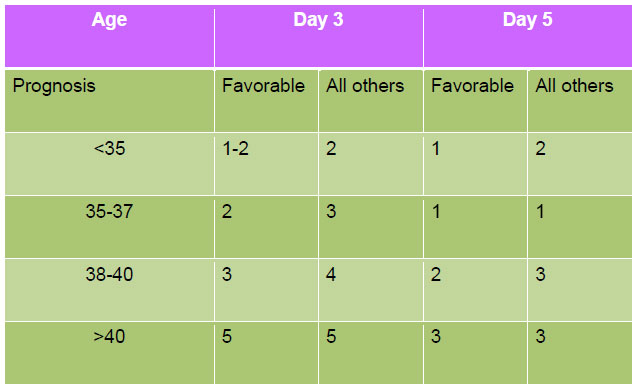Embryo Transfer
It is our goal to transfer the number of embryos that will give you your best chance for pregnancy while minimizing your risk for multiples. Your age and the quality of the blastocysts will also affect the actual number of embryos that your doctor will recommend for transfer. At NFC, we make our recommendation on the number of embryos to transfer based on the ASRM guidelines.
Single Embryo Transfer Reduces the Risk of Multiples while Maintaining a Good Chance for Pregnancy
If you are <35 yo, have good blastocysts available for transfer, and have additional blastocysts available for cryopreservation, then you maybe a candidate for a single embryo transfer (SET). At NFC we have found that for patients that meet SET criteria, their chance for pregnancy is the same whether we transfer 1 or 2 embryos, but transferring one embryo drops the chance of multiples to <2%!
NFC follows ASRM guidelines on the number of embryos to transfer.
Day 3 vs Day 5 Transfer
We transfer embryos either on day 3 or day 5 of culture (remember that egg retrieval is day 0). On day 3, embryos have ~8 cells and on day 5 embryos have developed to the blastocyst stage. At NFC about three quarters of our patients have a day 5 transfer; these are generally patients with multiple good quality embryos. A day 5 transfer allows the best embryo(s) to be selected for transfer. However, some of our patients will benefit from a day 3 transfer. If their embryos are growing slowly or if they have a limited number of embryos, the embryos will undergo assisted hatching and the transfer will occur on day 3.
Embryo Transfer Procedure
The transfer of the embryo(s) to your uterus is usually a simple procedure that is associated with little or no discomfort. You may take valium beforehand if you choose to. Your embryos may have assisted hatching. A speculum is placed in the vagina and the cervix is cleansed. The embryos are loaded into a soft, thin catheter. The physician will place the catheter through the cervix to the top of the uterus where they are released from the catheter.
Embryo transfer at NFC is done under direct visualization using an abdominal ultrasound scanner and usually requires only 20 minutes or so to complete. Ultrasound guided transfer requires a full bladder for best visualization. You may empty your bladder as soon as 15 minutes after the transfer.
Post-Transfer
After the embryo transfer, we ask that you rest for one hour at our center before going home. We require that someone else drive you home if you have taken medication. When home, we advise that you have ‘couch potato’ rest for the remainder of the day. Your activity after your transfer will not affect your chance for becoming pregnant, but we think it makes sense for you to have minimal activity after transfer. You may return to your normal routine (excluding strenuous activities) after the day of rest is complete. Prolonged rest is discouraged.
The blastocysts in excess of the number transferred may be cryopreserved or frozen for your future use.
A blood pregnancy test will be performed 11 to 12 days after a Day 5 embryo transfer, 13 to 14 days after a Day 3 transfer.


